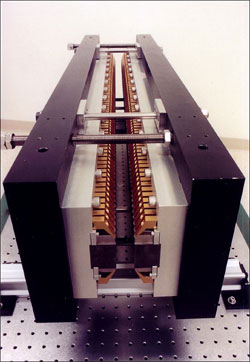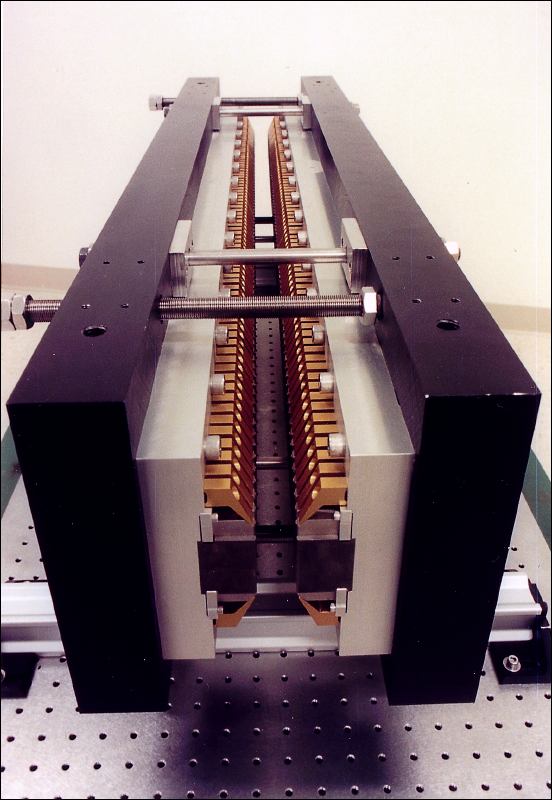Landmarks: Lasing with Electrons
Focus Landmarks feature important papers from the archives of the Physical Review. During 2010, the 50th anniversary of the invention of the laser, we’re highlighting some laser-related papers, as part of LaserFest.
Traditional lasers have been essential in science and technology, but each one is limited in the wavelengths at which it can operate. Two papers published in Physical Review Letters in 1976 and 1977 described a wholly new kind of laser that could in principle operate over a wide range of wavelengths. Today, these so-called free electron lasers provide high intensity from microwaves all the way up to x rays, with applications ranging across biology, chemistry, and physics.
Conventional lasers rely on the process of stimulated emission, described by Albert Einstein. Electromagnetic radiation of the correct wavelength triggers atoms or molecules in an excited state to emit more radiation of the same wavelength, and the emitted radiation is in phase (or “coherent”) with the triggering radiation [see 2005 Focus story, Invention of the Maser and Laser].
In 1971, John M. J. Madey of Stanford University in California showed theoretically that stimulated emission can also occur with bremsstrahlung, the radiation that a charged particle emits when forced to follow a curved path [1]. He considered a beam of electrons traveling close to the speed of light through a magnetic field oriented perpendicular to its path. He assumed a field that varies periodically in a way that forces the electrons to wiggle from side to side (or up and down), and as they wiggle, they emit radiation, concentrated in the forward direction.
Madey showed that if radiation of the right frequency travels along the same axis as the electron beam, it can stimulate additional bremsstrahlung radiation with the same frequency and phase. Unlike a conventional laser, however, where the operating frequency is a fixed property of the atoms or molecules at hand, the frequency of stimulated emission from “free electrons” depends only on the energy of the electrons and the magnetic field periodicity. So the wavelength can in principle be adjusted over a very wide range, just by varying the electron beam energy.
It was five years before Madey and several Stanford colleagues demonstrated the effect and reported it in Physical Review Letters. To provide a periodic magnetic field with the necessary strength and structure, the team built a superconducting electromagnet just over 5 meters long, with a period of 3.2 centimeters. Through the center of this magnet they directed a pulsed beam of electrons with energy of about 24 MeV from the Stanford Linear Accelerator Center (SLAC), along with laser light with a 10.6-micron wavelength. They observed a 7 percent amplification of the laser light when the electron beam energy had the right value to allow stimulated emission at the laser frequency.
The following year, Madey and colleagues published their account of the first free electron laser (FEL). It used the same apparatus as the earlier experiment, with a beam energy of 43.5 MeV, but now enclosed between two mirrors and without an external light source. Radiation generated spontaneously by the electron beam reflected back and forth between the mirrors, stimulating further emission to form a strong beam at an infrared wavelength of 3.4 microns.
Although Madey couched his theory in quantum mechanical terms, the working of FELs is now almost always described classically, says Joe Frisch of SLAC’s Linac Coherent Light Source (LCLS), an FEL operating at x-ray wavelengths. In this picture, there is an interaction between the sideways motion of electrons and the radiation’s sideways electric field that ultimately causes the electrons to form into “microbunches” spaced just a wavelength apart. Each bunch is at the same point in the wave, so their wiggling creates additional waves that are guaranteed to be in synch with the radiation that is already present.
At the LCLS, says Frisch, the electron-wiggling magnets (the undulators) have a 3-centimeter period, and electrons passing through them form into microbunches over about the first 100 periods. During the rest of their trip, the bunches generate coherent x rays with enough intensity that mirrors aren’t necessary–a good thing, as no such mirrors exist for x rays. LCLS was the first FEL to generate x rays of sub-nanometer wavelength, with an energy of about 10 keV. Brief, intense pulses of x rays can image individual atoms, making it possible to follow the progress of chemical reactions. FELs are also invaluable in generating high power at infrared frequencies and below, with uses ranging from studies of molecular structure to medical diagnostics.
–David Lindley
David Lindley is a freelance science writer in Alexandria, Virginia.
References
- John M. J. Madey, “Stimulated Emission of Bremsstrahlung in a Periodic Magnetic Field,” J. Appl. Phys. 42, 1906 (1971)





